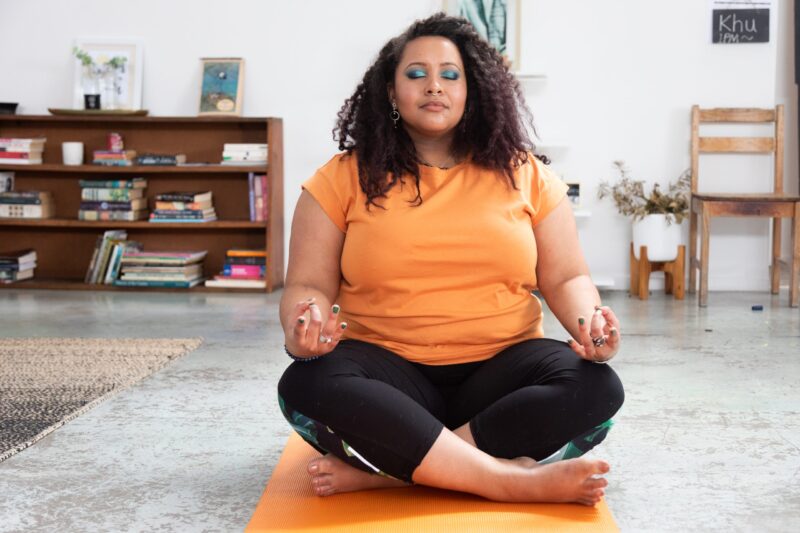
Many people believe that a quiet space, special music, or specific rituals are necessary for meditation. However, you can do it anytime, for example while waiting for the bus, taking a break during work, or in the midst of traffic congestion.
Meditation is one form of practice to focus and clear the mind, so you can feel calmer, more comfortable, and productive. This practice is generally done by sitting quietly, closing your eyes, and regulating your breathing slowly and regularly, at least for 10–20 minutes.
Yes, stress is indeed an inevitable part of life for everyone, especially for those with busy routines. To cope with stress, one can engage in meditation, one of which is mindfulness meditation.
What Are the Meditation Techniques for Stress Relief?
Mindfulness meditation creates a space between the mind and reactions to stress triggers. It brings one to a state of being aware of thoughts without feeling judged.
In fact, there are many benefits to meditation, including improving sleep quality, managing moods, increasing focus, and addressing specific conditions such as Parkinson’s disease, insomnia, depression, and more.
To practice mindfulness meditation, there are several techniques to be aware of. Techniques for relieving stress through mindfulness meditation include:
a. Attention Meditation Technique
This technique relies on focusing attention on the breath, coupled with recognizing and exploring thoughts that may arise. In essence, it’s like standing on the riverbank, enjoying the flow without diving directly into it.
b. Music Meditation Technique
This technique involves using music throughout the process. You can meditate with different music and rhythms. Especially for those suffering from tinnitus (perceiving silence as disturbing), using this technique to relieve stress is an excellent choice.
See also : Achieving a Clutter-Free Home: Minimalist Living Tips
c. Body Scanning Meditation Technique
This technique directs attention gradually from one part of the body to another. For example, you can start by focusing attention from the toes to the head. During body scanning meditation, stress-triggering thoughts gradually shift to calming and positive thoughts.
d. Mantra Meditation Technique
Mantra meditation uses calming words or phrases. These mantras divert disturbing thoughts. This technique can be likened to a lullaby, with each verse bringing you into a calm and relaxed state.
e. Walking Meditation Technique
When you hear the term meditation, you might associate it with sitting still. However, meditation doesn’t always have to be static. Walking meditation combines physical activity with full awareness, making it a suitable choice for those who enjoy being active.
f. Loving-Kindness Meditation Technique
Loving-kindness meditation involves sending good intentions, doing good deeds, and mentally expressing affection for oneself, followed by expressing feelings of love. Examples of loving-kindness phrases include “may you always be happy, healthy, and peaceful.” You can also use other beautiful phrases to cultivate positive feelings and alleviate stress.
How to Practice Mindfulness Meditation?
After learning mindfulness meditation techniques, here’s how to practice it:
1. Choose the Right Environment
The environment plays a crucial role in the success of your meditation. Start by finding the right practice space. You can meditate indoors, in a garden surrounded by trees, or in a place free from stress-triggering work environments.
Next, find comfort. You can adjust the room temperature, sit on a soft cushion, and allocate time. Meditation time can start from 10 minutes or can be adjusted according to your needs.
See also : Healthy Meal Prep Ideas to Ease Busy Weekdays
2. Begin Meditating
Once you’ve found the right environment, you must manage your thoughts and take deep breaths when starting meditation. During the meditation process, position yourself as not being what is in your mind.
3. Practice Mindfulness Techniques
Lastly, you can practice the mindfulness techniques mentioned earlier. Just as in weight loss, you must eat calmly or meditate while walking to keep your muscles moving and not tense.
Also, focus on the sensations you’re experiencing. Especially if your body feels pain or tension in certain areas, you can start meditating by focusing on those areas.
Basically, anything a person does can be turned into meditation. You can start meditating while brushing your teeth, driving a car, and so on. However, the most important thing is to meditate gradually so that your focus is not divided by various distractions, maintaining comfort and peace during the meditation process.
It’s important to note that meditation is an individual journey aimed at self-exploration and finding what works for you. Therefore, the mindfulness meditation techniques above are not a universal solution to the stress you face. In fact, with just one meditation technique, you can achieve what you desire.
